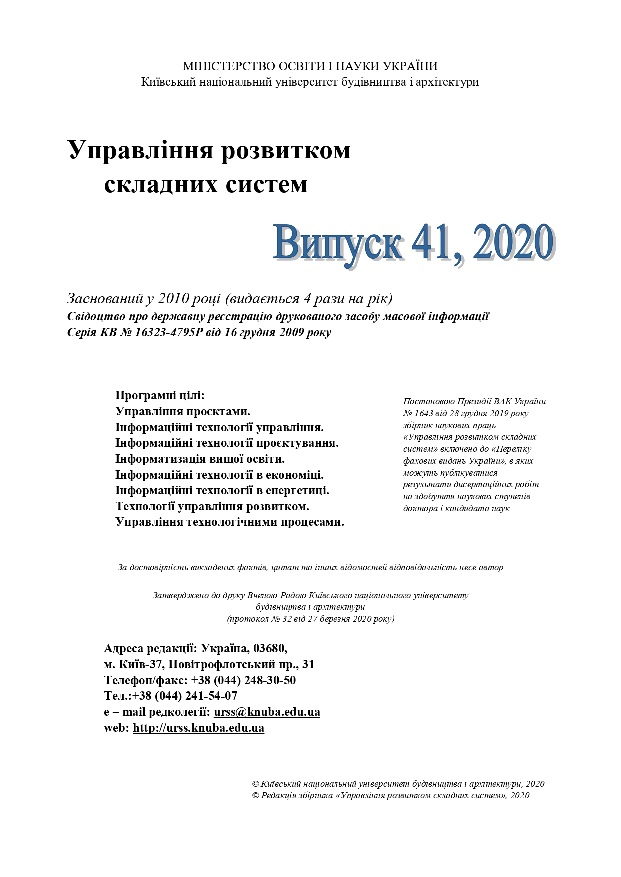АЛЬТЕРНАТИВНЫЕ ПОДМНОЖЕСТВА УПОРЯДОЧЕННЫХ ПАР И ИХ ПРИМЕНЕНИЕ В ЗАДАЧАХ ПРИНЯТИЯ РЕШЕНИЙ В УСЛОВИЯХ НЕОПРЕДЕЛЕННОСТИ
DOI:
https://doi.org/10.32347/2412-9933.2020.41.68-82Ключові слова:
принятие решений, условия неопределенности, нечеткое множество, функция принадлежности, тензор, сингулярная декомпозиция, теплицева матрица, подмножество упорядоченных парАнотація
Показана возможность формирования подмножество упорядоченных пар на основании тензоризации интервала универсального множества с последующей декомпозицией. В качестве одного из способов тензоризации и учета феномена нечеткости предложено использовать теплицеву матрицу, наиболее эффективно моделирующую нечеткость. Универсальное множество (УМ), на котором сформировано НМ, в тензорном формате содержит скрытую информацию, которая может быть использована при принятии решения не менее эффективно, чем эвристически назначенная ФП. Кроме того, наличие формально вычисленного ПмУП может служить убедительным сравнительным примером: располагая данным ПмУП, можно объективно отказаться от назначения эвристической ФП. Установлено, что ПмУП обладают существенно меньшей интервальной неопределенностью; приведены примеры, показывающие более высокую эффективность использования ПмУП по сравнению со стандартно сформированными НМ.Посилання
Zimmermann, H.-J. (2001). Fuzzy set theory and its applications. 4-th edn. Publisher, Kluwer Pub., Boston. [In USA].
Hanss, M. (2001). Applied Fuzzy Arithmetic: An Introduction with Engineering Applications. Springer Science & Business Media. Retrieved from https://www.springer.com/gp/book/9783540242017#.
Val'kman, Yu.R., Bykov, V.S., Rykhal'skiy, A.Yu. (2007). Modelling of NE-factors – bases of intellegement. System investigations and information technologies, 1, 39-61. Kyiv [In Ukraine].
Ashfaq, M.S. (2018) A Tribute to Father of Fuzzy Set Theory and Fuzzy Logic. International Journal of Swarm Intelligence and Evolutionary Computation, 7 (2), 1-5. Retrieved from https://www.longdom.org/open-access/a-tribute-to-father-of-fuzzy-set-theory-and-fuzzy-logic-dr-lotfi-azadeh-2090-4908-1000170.pdf.
Narinyani, A.S. (2008) Non-factors: Inaccuracy and Underdeterminacy- distinction and interrelation (pre-formal research). Retrieved from http://viperson.ru/articles/aleksandr-narinyani-ne-faktory-netochnost-i-nedoopredelennost-razlichie-i-vzaimosvyaz.
Narinyani, A.S. (2004). Knowledge Engineering and Non-Factors: An Overview. Retrieved from http:// www. computer-museum.ru/frgnhist/ne-faktor.htm.
Black, М. (1997). Vagueness: An exercise in logical analysis. Philosophy of Science 4: Reprinted in R. Keefe, P. Smith (eds.): Vagueness: A Reader, MIT Press, 427–455.
ZadehL. A. (1965). Fuzzy Sets. In: Journal of Information and control, 8, 338-353. Retrieved from https://www.sciencedirect.com/science/article/pii/S001999586590241X.
Hisdal, E. (1988). The Philosophical interpretation of the theory of fuzzy sets. Journal of Fuzzy Sets and Systems, 25, 349-356. Retrieved from https://www.sciencedirect.com/science/article/abs/pii/016501148890019X.
Seising, R. (2009). Fuzzy Sets and Systems and Philosophy of Science. Views on Fuzzy Sets and Systems from Different Perspectives. Studies in Fuzziness and Soft Computing, 243, 1-35. Springer, Berlin, Heidelberg. [In FRG].
Vyatchenin, D. A. (1998). The problem of fuzziness as a scientific concept: philosophical and methodological analysis; Filosofiy nauki i texniki 09.00.08, Extended abstract of candidate’s thesis. Sumy: SumSU. [In Belarus].
Vyatchenin D. A., Khizhnyak, A. V. ShevyakovA.V. (2012). Fuzzy clustering and fuzzy mathematical morphology in image processing problems: Monography. Minsk. [In Belarus].
Kaneman D., Slovik P., Tverski A. (2005). Judgment under Uncertainty: Heuristics and biases. Khar'kov. [In Ukraine].
Perepelitsa V.A., Tebuyeva F.B. (2007). Discrete optimization and modeling in the face of data uncertainty Moscou. [In Russia].
Debnath, A., Rai, H., Yadav, C., Agarwal, A. (2013). Deblurring and Denoising of Magnetic Resonance Images using Blind Deconvolution Method. Journal of Computer Applications, 81, 7-12. Retrieved from https://www.semanticscholar.org/paper/Deblurring-and-Denoising-of-Magnetic-Resonance-Debnath-Rai/28db34037d247489433e3fd9b128fa1669082326.
Cichocki, A. et al. (2015). Tensor decompositions for signal processing applications: From twoway to multiway component analysis. Journal Signal Processing Magazine, 32, 145 – 163. Doi: 10.1109/MSP.2013.2297439 .
Gonsales, R., Vuds, R., Eddins, S. (2006). Digital image processing in MATLAB / R. Gonzalez, R. Woods, S. Eddins // Moscow, 245. [In Russia].
Chaudhuri, S., Velmurugan, R., Rameshan, R. (2014). Blind Image Deconvolution: Methods and Convergence. Springer International Publishing. Retrieved from https://doi.org/10.1007/978-3- 319-10485-0.
Hansen, С., Nagy, J.G., O’Leary, D.P. (2006). Deblurring images: Matrices, spectra, and filtering. SIAM, PA, 130.
Gray, R.M. (2018). Toeplitz and Circulant Matrices: A review. Department of Electrical Engineering Stan-ford University. Stanford, 94305. Retrieved from https://ee.stanford. edu/~gray/toeplitz. last accessed 2018/10/19. [In USA].
Tyrtyshnikov Ye. (2012). Methods of numerical analysis based on tensor representations. International Conference Schooi for Young Scientists “MPAMCS” Dubna. Russia. Retrieved from http://mpamcs2012.jinr.ru/file/tyrtyshnikov.pdf. last accessed 2019/05/12.
Tyrtyshnikov Ye. (2003). Tenzor approksimations of matrices, generated by asymptotically smooth funktions. In: Journal Sbornik Mathematics, vol. 194, 147–160. Retrieved from https://iopscience.iop.org/article/10.1070/SM2003v194n06ABEH000747.
Minaev Yu. N., Filimonova O. Yu., Minaeva J. I. (2014). Kronecker (tensor) models of fuzzy-set granules. In: Cybern. Syst. Analysis, vol. 50(4). 42 – 52. Retrieved from https://doi.org/10.1007/s10559-014-9640-6.
Zade, L. (1976). The Concept of a Linguistic Variable and its Application to Approximate Reasoning. Moscow, 167.
Pajarola, R., Ballester-Ripol, R. (2019). Tutorial: Tensor Decomposition Methods in Visual Computing. Tensor Decomposition Models. Retrieved from https://www.ifi.uzh.ch/dam/jcr:ded4873d-64d8-4ecf-b60f-fb2742d9c16/TA_Tutorial_Part1.pdf.
De Lathauver, L., De Moor, B., Vanderwalle, J. (2000). A Multilinear Singulatr Value Decomposition. Journal SIAM Journal on Matrix Analysis and Applications, 21(4), 1253–1278. Retrieved from https://epubs.siam.org/doi/10.1137/S0895479896305696.
Sebastian, S., Ramakrishnan, T. (2010). Multi-Fuzzy Sets. Journal International Maths Forum International Maths Forum, 50, 2471–2476. Retrieved from https://www.researchgate.net/publication/284899193_Multi-Fuzzy_Sets.
Costantini, R., Sbaiz, L., Susstrunk, S. (2008). Higher order SVD analysis for dynamic texture synthesis. Journal IEEE Trans. Image Process, 17(1), 42–52. Retrieved from https://www.ncbi.nlm.nih.gov/pubmed/18229803.
Minayev, Yu.N., Filimonova, O.Yu., Minayeva, J.I. (2019). Multi-fuzzy sets as aggregation subjective and objective fuzziness. Mathematics. Information Technologies. Education "Modern Machine Learning Technologies and Data Science, MoMLeT and DS 2019. Retrieved from http://ceur-ws.org/Vol-2386/[In Ukraine].
##submission.downloads##
Опубліковано
Як цитувати
Номер
Розділ
Ліцензія
Авторське право (c) 2020 Julia Minaeva, Oksana Filimonova

Ця робота ліцензується відповідно до Creative Commons Attribution-NonCommercial-NoDerivatives 4.0 International License.

